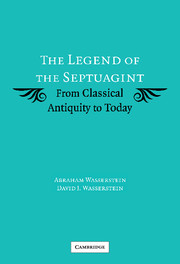Book contents
- Frontmatter
- Contents
- Preface and Acknowledgments
- Abbreviations
- Introduction
- 1 The Letter of Aristeas
- 2 The Hellenistic Jewish Tradition
- 3 The Rabbis and the Greek Bible
- 4 The Ptolemaic Changes
- 5 The Church Fathers and the Translation of the Septuagint
- 6 Among the Christians in the Orient
- 7 The Muslims and the Septuagint
- 8 Yosippon and the Story of the Seventy
- 9 Karaites, Samaritans and Rabbanite Jews in the Middle Ages
- 10 The Septuagint in the Renaissance and the Modern World
- Conclusion
- Appendix: In Partibus Infidelium: Zosimus of Panopolis
- Bibliography and Sources
- Index
10 - The Septuagint in the Renaissance and the Modern World
Published online by Cambridge University Press: 17 July 2009
- Frontmatter
- Contents
- Preface and Acknowledgments
- Abbreviations
- Introduction
- 1 The Letter of Aristeas
- 2 The Hellenistic Jewish Tradition
- 3 The Rabbis and the Greek Bible
- 4 The Ptolemaic Changes
- 5 The Church Fathers and the Translation of the Septuagint
- 6 Among the Christians in the Orient
- 7 The Muslims and the Septuagint
- 8 Yosippon and the Story of the Seventy
- 9 Karaites, Samaritans and Rabbanite Jews in the Middle Ages
- 10 The Septuagint in the Renaissance and the Modern World
- Conclusion
- Appendix: In Partibus Infidelium: Zosimus of Panopolis
- Bibliography and Sources
- Index
Summary
Gedalya ibn Yahya marks the end of the pre-modern history of our story. His contemporary and fellow Jew Azaria de' Rossi points forward to the modern era. The two had much in common, and it is no accident that both should have lived in Italy. This meant, among other things, that they were both able to enjoy fairly easy access to non-Jewish literature and society more broadly considered while not losing either their roots in Jewish culture or their Jewish identity. In the case of Gedalya, as we have seen, the new books which he read, like the Letter, simply helped to increase the database, so to say, for his historical writing and to expand the story that he had to tell. Azaria de' Rossi, by contrast, who would probably have been a remarkable person in any context, was able to benefit much more from the broadening of horizons which life in renaissance Italy meant for Jews.
Our concern in this final chapter will be not so much with the story and its literary peregrinations and transformations as with the beginnings of modern critical study of the story and its background. The renaissance and the age of print gave a new lease of life to the legend which the Letter told. Its subject matter made the Letter of interest to three distinct, if overlapping, groups. First, as a Greek text from antiquity it excited interest among scholars of the ancient world.
- Type
- Chapter
- Information
- The Legend of the SeptuagintFrom Classical Antiquity to Today, pp. 238 - 269Publisher: Cambridge University PressPrint publication year: 2006



